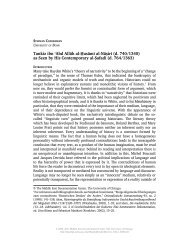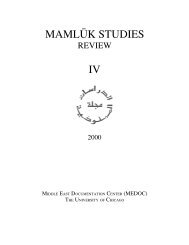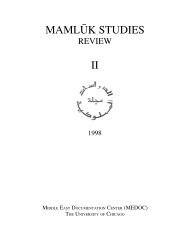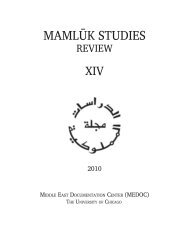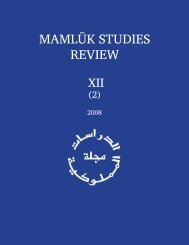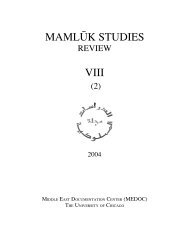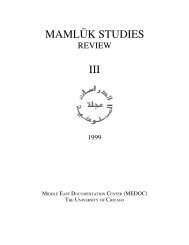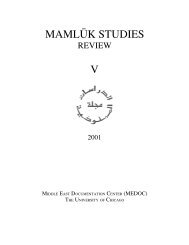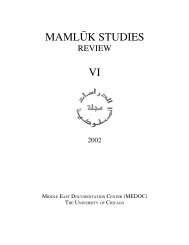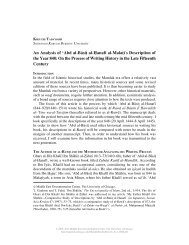Vol. VII, no. 1 (2003) - Mamluk Studies Review - University of Chicago
Vol. VII, no. 1 (2003) - Mamluk Studies Review - University of Chicago
Vol. VII, no. 1 (2003) - Mamluk Studies Review - University of Chicago
You also want an ePaper? Increase the reach of your titles
YUMPU automatically turns print PDFs into web optimized ePapers that Google loves.
MAMLU±K STUDIES REVIEW VOL. 7, <strong>2003</strong> 15<br />
Prophet and <strong>of</strong> Sufi saints, proverbs, animal fables, and entertaining stories. Many<br />
<strong>of</strong> the stories were <strong>of</strong> an improving nature and most <strong>of</strong> it fairly unsophisticated.<br />
Stories about simple saints and poor artisans carried a message that the reader<br />
should be patient with his lot and content with what God had decreed. However,<br />
some tales seem to have been included simply for the comic or erotic pleasure<br />
they afforded. 41<br />
By contrast with al-Ibsh|h|'s well-k<strong>no</strong>wn collection, the Fakiha≠t al-Khulafa≠’<br />
wa-Mafakiha≠t al-Z˝urafa≠’ <strong>of</strong> Ah˝mad ibn Muh˝ammad ibn ‘Arabsha≠h<br />
(791–854/1392–1450) has had little attention paid to it in recent centuries. The<br />
Fakiha≠t, in which animals tell entertaining and improving tales, was modeled on<br />
the Persian Marzuba≠n-na≠mah <strong>of</strong> al-Wara≠w|n|, and, like its prototype, it aimed at<br />
an exalted audience, for it was a work in the mirror-for-princes genre. It considerably<br />
expanded on its Persian original and included quite a lot <strong>of</strong> material concerning<br />
recent Mongol and Timurid history. Ibn ‘Arabsha≠h modeled his style as well his<br />
content upon Persian exemplars and wrote in a torturous and metaphor-laden<br />
rhymed prose. Having spent his youth in Samarkand, he had travelled widely<br />
since then, and he wrote copiously in both Arabic and Turkish (but it is dispiriting<br />
to find how little attention has been paid to his literary oeuvre). Ibn ‘Arabsha≠h's<br />
Al-Ta’l|f al-T˛a≠hir was both a royal biography and a mirror-for-princes, with the<br />
Sultan Jaqmaq as the model ruler that other princes should follow. Though it<br />
seems to have been written in the hope that the exemplary prince would release<br />
Ibn ‘Arabsha≠h from prison in Cairo, in fact its author was released only a few<br />
days before his death. His better-k<strong>no</strong>wn ‘Aja≠’ib al-Maqdu≠r f| Nawa≠’ib T|mu≠r, a<br />
history <strong>of</strong> the career <strong>of</strong> the villai<strong>no</strong>us T|mu≠r, or Tamerlane, was written in Arabic,<br />
but again in the Persianate manner. Although it was a popular subject <strong>of</strong> study for<br />
eighteenth- and nineteenth-century Orientalists, it seems to have had little or <strong>no</strong><br />
influence on chroniclers <strong>of</strong> the <strong>Mamluk</strong> period, perhaps because <strong>of</strong> its rebarbative,<br />
ornate style, so different from the workaday prose <strong>of</strong> al-Maqr|z| or Ibn Taghr|bird|.<br />
Even so, it should be <strong>no</strong>ted that Ibn Taghr|bird| was a fan <strong>of</strong> Ibn ‘Arabsha≠h and<br />
got an ija≠zah to teach his writings. 42<br />
41 Muh˝ammad ibn Ah˝mad al-Ibsh|h|, Al-Mustat¸raf f| Kull Fann Mustaz˝raf, trans. Gustave Rat, 2<br />
vols. (Paris and Toulon, 1899–1902); idem, Les Poètes amoureux, trans. René Khawam (Paris,<br />
1999); Octave Houdas, "Al-Mostatraf," Journal asiatique, 9th ser., 15 (1900): 388–90; Timo<br />
Paajanen, Scribal Treatment <strong>of</strong> the Literary and Vernacular Proverbs <strong>of</strong> al-Mustat¸raf in 15th–17th<br />
Century Manuscripts (Helsinki, 1995).<br />
42 Ah˝mad ibn Muh˝ammad Ibn ‘Arabsha≠h, ‘Aja≠’ib al-Maqdu≠r f| Nawa≠’ib T|mu≠r, ed. Ah˝mad Fa≠’iz<br />
al-H˛ims˝| (Beirut, 1986); idem, Fructus Imperatorum et Iocatio Ingeniosorum (Fa≠kihat al-Khulafa≠’<br />
wa-Mufa≠kihat al-Z˝urafa≠’), ed. G. W. Freytag (Bonn, 1832); idem, Tamerlane; or Timur the Great<br />
Amir, trans. J. H. Sanders (London, 1936); Antoine Isaac Sylvestre de Sacy, "Liber Arabicus,"<br />
Journal des Savants (1835): 602–12, 652–67; J. Pedersen, "Ibn ‘Arabshah," EI 2 , 3:711–12; Robert<br />
Irwin, "What the Partridge Told the Eagle: A Neglected Source on Chinggis Khan and the Early<br />
© <strong>2003</strong>, 2012 Middle East Documentation Center, The <strong>University</strong> <strong>of</strong> <strong>Chicago</strong>.<br />
http://mamluk.uchicago.edu/<strong>Mamluk</strong><strong>Studies</strong><strong>Review</strong>_<strong>VII</strong>-1_<strong>2003</strong>.pdf



